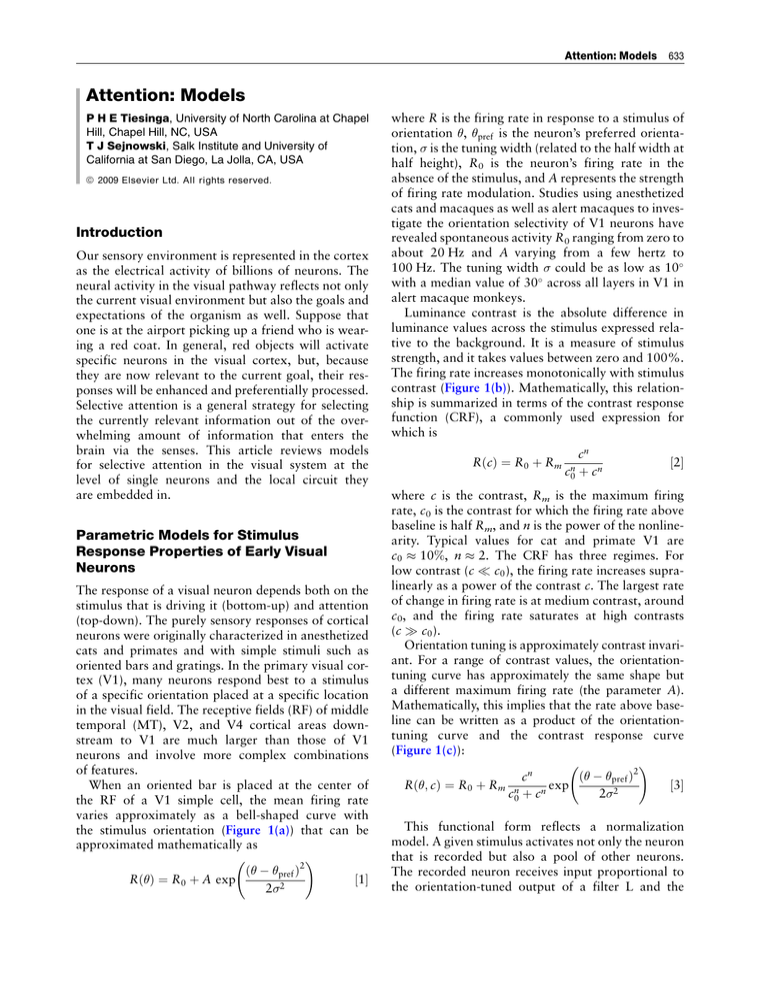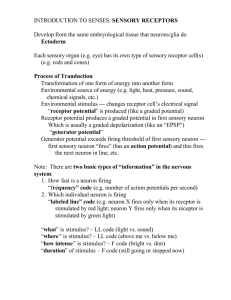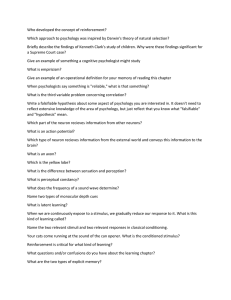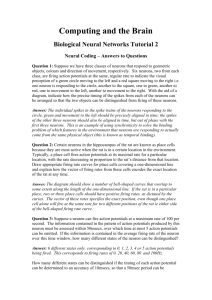Attention: Models
advertisement

Attention: Models 633 Attention: Models P H E Tiesinga, University of North Carolina at Chapel Hill, Chapel Hill, NC, USA T J Sejnowski, Salk Institute and University of California at San Diego, La Jolla, CA, USA ã 2009 Elsevier Ltd. All rights reserved. Introduction Our sensory environment is represented in the cortex as the electrical activity of billions of neurons. The neural activity in the visual pathway reflects not only the current visual environment but also the goals and expectations of the organism as well. Suppose that one is at the airport picking up a friend who is wearing a red coat. In general, red objects will activate specific neurons in the visual cortex, but, because they are now relevant to the current goal, their responses will be enhanced and preferentially processed. Selective attention is a general strategy for selecting the currently relevant information out of the overwhelming amount of information that enters the brain via the senses. This article reviews models for selective attention in the visual system at the level of single neurons and the local circuit they are embedded in. Parametric Models for Stimulus Response Properties of Early Visual Neurons The response of a visual neuron depends both on the stimulus that is driving it (bottom-up) and attention (top-down). The purely sensory responses of cortical neurons were originally characterized in anesthetized cats and primates and with simple stimuli such as oriented bars and gratings. In the primary visual cortex (V1), many neurons respond best to a stimulus of a specific orientation placed at a specific location in the visual field. The receptive fields (RF) of middle temporal (MT), V2, and V4 cortical areas downstream to V1 are much larger than those of V1 neurons and involve more complex combinations of features. When an oriented bar is placed at the center of the RF of a V1 simple cell, the mean firing rate varies approximately as a bell-shaped curve with the stimulus orientation (Figure 1(a)) that can be approximated mathematically as ! ð pref Þ2 RðÞ ¼ R0 þ A exp ½1 22 where R is the firing rate in response to a stimulus of orientation , pref is the neuron’s preferred orientation, is the tuning width (related to the half width at half height), R0 is the neuron’s firing rate in the absence of the stimulus, and A represents the strength of firing rate modulation. Studies using anesthetized cats and macaques as well as alert macaques to investigate the orientation selectivity of V1 neurons have revealed spontaneous activity R0 ranging from zero to about 20 Hz and A varying from a few hertz to 100 Hz. The tuning width could be as low as 10 with a median value of 30 across all layers in V1 in alert macaque monkeys. Luminance contrast is the absolute difference in luminance values across the stimulus expressed relative to the background. It is a measure of stimulus strength, and it takes values between zero and 100%. The firing rate increases monotonically with stimulus contrast (Figure 1(b)). Mathematically, this relationship is summarized in terms of the contrast response function (CRF), a commonly used expression for which is RðcÞ ¼ R0 þ Rm cn cn0 þ cn ½2 where c is the contrast, Rm is the maximum firing rate, c0 is the contrast for which the firing rate above baseline is half Rm, and n is the power of the nonlinearity. Typical values for cat and primate V1 are c0 10%, n 2. The CRF has three regimes. For low contrast (c c0 ), the firing rate increases supralinearly as a power of the contrast c. The largest rate of change in firing rate is at medium contrast, around c0, and the firing rate saturates at high contrasts (c c0 ). Orientation tuning is approximately contrast invariant. For a range of contrast values, the orientationtuning curve has approximately the same shape but a different maximum firing rate (the parameter A). Mathematically, this implies that the rate above baseline can be written as a product of the orientationtuning curve and the contrast response curve (Figure 1(c)): ! ð pref Þ2 cn Rð; cÞ ¼ R0 þ Rm n exp ½3 c0 þ cn 22 This functional form reflects a normalization model. A given stimulus activates not only the neuron that is recorded but also a pool of other neurons. The recorded neuron receives input proportional to the orientation-tuned output of a filter L and the Firing rate (Hz) a b 100 50 0 −50 0 50 Stimulus orientation (deg) 100 R(q, c) (Hz) Firing rate (Hz) 634 Attention: Models 100 50 0 50 50 c q (deg) 102 0 −50 101 c (%) 0 100 101 102 Stimulus contrast (%) Figure 1 (a) Orientation-tuning curve. (b) Contrast response function. (c) The firing rate, according to eqn [3], as a function of orientation and contrast c. contrast c. The combined activity of neurons in the pool is independent of stimulus orientation, but it increases with contrast as cn. This activity divisively normalizes the response of the recorded neuron. The normalization model can account for a large number of experimentally measured responses. Model studies and in vitro experiments show that a number of biophysical mechanisms yield divisive normalization. An alternative means of achieving normalization involves the short-term plasticity of the synapses onto the neuron. Parametric Models for Attentional Modulation of Early Visual Responses The modulation by selective attention of neural responses has been studied in awake nonhuman primates. The strongest modulation of individual neurons was recorded in the MT, V4, and inferotemporal cortical areas, which all are downstream of V1. In one experimental paradigm, two equivalent arrays of stimuli are presented, typically on opposite sides of the vertical meridian. The monkey is rewarded for detecting a subtle change in the stimulus at a cued location. It is not rewarded for reporting a change in a stimulus at the noncued location. Since this is a difficult task, the monkey needs to pay attention to the cued location in order to observe and respond to the stimulus change. The neuron that is recorded has its receptive field at one of the two locations. Hence, the response of that neuron to the same stimulus with attention can be compared with when attention is directed at the location outside the neuron’s RF. Attention modulates the firing rate. For spatial attention, the firing rate typically increases when the neuron’s receptive field overlaps with the area where attention is directed. The neuron receives feed-forward synaptic inputs and transforms them into a firing rate. Attention could act in several ways: it could make the feed-forward input stronger, or it could change the gain of the input-to-output transformation. The former is referred to as contrast gain and the latter as response gain. In Figure 2(a), illustrating contrast gain, the CRF with attention (left curve) is plotted together with the curve for attention directed away from the RF (right curve). Attention shifted the curve to the left, which implies that a neuron responds to a stimulus as if it had a contrast higher than its actual (veridical) contrast. Contrast gain has three distinguishing properties. First, with attention the neuron will respond to low-contrast values that it did not respond to without attention. Second, the largest change in firing rate will occur for moderate firing rates corresponding to contrasts around c0. Third, the saturation firing rate remains the same, but it is reached for a lower value of the contrast than without attention. Response gain is illustrated in Figure 2(b). The CRF with attention is obtained by multiplying the CRF without attention by a gain factor larger than unity. Response gain can be distinguished from contrast gain. First, if the neuron does not respond to a low-contrast stimulus without attention, neither will it do so with attention. Second, the largest change in firing rate will occur at the highest value of the contrast where the neuron fires at its highest rate. Third, the saturation rate will be higher for attention compared with no attention. Experiments in a spatial attention paradigm in cortical areas MT and V4 of macaque show that attentional modulation of the CRF is best described as contrast gain. This matches the results of psychophysical experiments: Human observers report that the perceived contrast of a stimulus is higher if it is in the focus of attention. Other experiments on the Attention: Models Response gain Firing rate (Hz) Contrast gain 100 100 50 50 0 0 10 a 101 Stimulus contrast 635 0 102 100 b 101 Stimulus contrast 102 Spikes s−1 50 mV Figure 2 Attentional modulation of the contrast response function when attention is directed away from (blue) or directed toward (green) the receptive field of the recorded neurons. Illustration of (a) contrast gain and (b) response gain. 50 50 0 500 a 1000 1500 2000 2500 t (ms) 50 0 100 b 600 t (ms) Firing rate (Hz) 50 0 c 0 2 4 Injected current (µA cm−2) 2 4 6 d Injected current (µA cm−2) Figure 3 Response gain and contrast gain can be mediated by modulation of inhibitory synaptic inputs. (a, b): (top) Example voltage trace and (bottom) spike time histogram based on 500 trials. (a) The model neuron was driven by synchronous inhibitory and asynchronous excitatory inputs. During the interval between 1000 and 2000 ms, the jitter of the inhibitory volleys was decreased from 4 to 2 ms. During the period of increased inhibitory synchrony (low jitter), the firing rate was increased from 22 to 35 Hz. (b) The model neuron was driven by synchronous inhibition and a constant depolarizing current. During the interval between 300 and 700 ms, the jitter of the inhibitory volleys was decreased from 8 to 2 ms. The inhibitory inputs act as a gate. During periods of low inhibitory synchrony (high jitter), the neuron does not spike, whereas during periods of high inhibitory synchrony, it does spike. (c) and (d) The firing rate vs. current curves. Response gain: in (c) the synchronous inhibitory volleys consisted on average of ten presynaptic spikes, the jitter was, from top to bottom: 1, 2, 3, 4, and 5 ms. Inset: the five curves were made to overlap by scaling the firing rate and by small shifts in the current. Contrast gain: in (d) the synchronous inhibitory volleys consisted on average of 50 presynaptic spikes, and jitter was, from left to right, 1, 3, and 5 ms. Reproduced from Tiesinga PH, Fellous JM, Salinas E, Jose JV, and Sejnowski TJ (2004) Inhibitory synchrony as a mechanism for attentional gain modulation. Journal of Physiology-Paris 98: 296–314, with permission from Elsevier. modulation of orientation tuning curves were best described as a response gain with attention. Overall, there is evidence in support of response gain, as well as contrast gain, depending on the specific details of the behavioral task by which attentional modulation was studied. In experiments designed to study feature-based attention in area MT, effects consistent with response gain were found. The neuron’s response was multiplied by a gain factor that monotonically increases with the difference between the attended feature (direction, color, or shape) and the feature value preferred by the neuron. A similar effect of feature-based attention was obtained in fMRI experiments with human participants. The response of MT to a moving random dot pattern was increased when it was task-relevant. In macaque visual cortex, attention led in some, but not all, cases to an increase in baseline rate (R0). Thus, the response to a stimulus of contrast c and orientation can be described by eqn [3]. In this expression, attention ‘a’ enters via the baseline rate R0 ðaÞ and the contrast threshold c0 ðaÞ. The effects of attention are consistent with either response gain or contrast gain depending on which stimulus parameter 636 Attention: Models is varied. This form makes a prediction that has recently been confirmed experimentally: the response to a stimulus of nonoptimal orientation should saturate at the same contrast as a stimulus with optimal orientation. Biophysical Models for Attentional Response Modulation A biophysical model must account for the inputs a neuron receives from three sources: feed-forward input that represents stimulus aspects (bottom-up), modulatory feedback input (top down), and recurrent connections within the same cortical area (but potentially different layers). The recurrent activity depends both on bottom-up and top-down inputs. Furthermore, the bottom-up input includes the influence of top-down projections on the earlier cortical area. Response mechanisms can be studied theoretically and in vitro at the single-neuron level under the assumption that the three sources of synaptic inputs can be split up in two sets of independent inputs, one of which depends only on the stimulus identity and contrast, the other only on the locus of attention. The rate of stimulus-related synaptic inputs depends, as a bell-shaped tuning curve, on the stimulus orientation, with excitatory inputs dominating inhibitory inputs. The attention-related inputs consist of approximately equally strong excitatory and inhibitory inputs. Thus the main contribution of attention consists of modulating fluctuating inputs. Two mechanisms have been proposed that are based on the idea that attention modulates the amount of fluctuation. First, in gain modulation by balanced synaptic inputs, attention causes a proportional change in rates of excitatory and inhibitory inputs such that the variance of the membrane potential changes but its mean remains the same. Second, in gain modulation by correlation, there is a change in correlation between inputs such as the synchrony of inhibitory inputs or the delay between excitatory and inhibitory inputs. Both of these proposed mechanisms are supported by in vitro experiments. The basic paradigm is as follows: in the experiments, feed-forward inputs are presented by a constant depolarizing input current I injected at the soma, whereas the modulatory inputs are injected at the soma using dynamic clamp. The firing rate versus current curve (f–I) is then constructed by calculating the firing rate for a set of different values of I in the presence of the modulatory inputs. Chance and co-workers have shown that an increase in the level of balanced synaptic inputs yields a decrease in the gain of the f–I curve. Tiesinga et al. have shown that an increase in inhibitory synchrony also leads to an increase in gain of the f–I or a shift in the f–I along the current ordinate (Figure 3). The single-neuron studies show how the response could be modulated, but they do not provide a mechanism at the local circuit level by which the necessary changes in the modulatory inputs come about. Furthermore, in the model as well as in vitro, the inputs were somatic, but the modulatory and feedforward inputs may impinge at different locations on the neuron’s extensive dendritic tree, which could introduce more complex dynamical interactions. Discussion This article has focused on the effects of attention on the response of a single neuron to a simple stimulus. Current experimental investigations are extending these results in two ways. First, in higher cortical areas, the receptive fields are so large that they accommodate multiple stimuli. Attentional modulation is much stronger when there are multiple stimuli in a receptive field. Phenomenological models are presently being developed to quantitatively account for these data. Second, even when attention does not change the firing rate, it may change the correlation between neurons. Experiments in V4 show that attention increases the coherence in the g-frequency range between neurons and the local field potential. This suggests an important role for the synchrony in networks mediating the effects of attention. Future theoretical research is directed at exploring the synchrony hypothesis at the level of the cortical circuit. See also: Attention and Eye Movements; Attentional Networks; Attentional Functions in Learning and Memory; Neglect Syndrome and the Spatial Attention Network; Sensorimotor Integration: Attention and the Premotor Theory; Visual Attention; Visual Motion Models. Further Reading Albrecht DG, Geisler WS, Frazor RA, and Crane AM (2002) Visual cortex neurons of monkeys and cats: Temporal dynamics of the contrast response function. Journal of Neurophysiology 88: 888–913. Bichot NP, Rossi AF, and Desimone R (2005) Parallel and serial neural mechanisms for visual search in macaque area V4. Science 308: 529–534. Chance FS, Abbott LF, and Reyes AD (2002) Gain modulation from background synaptic input. Neuron 35: 773–782. Ferster D and Miller KD (2000) Neural mechanisms of orientation selectivity in the visual cortex. Annual Review of Neuroscience 23: 441–471. Fries P, Reynolds JH, Rorie AE, and Desimone R (2001) Modulation of oscillatory neuronal synchronization by selective visual attention. Science 291: 1560–1563. Attention: Models Maunsell JH and Treue S (2006) Feature-based attention in visual cortex. Trends in Neurosciences 29: 317–322. Reynolds JH and Chelazzi L (2004) Attentional modulation of visual processing. Annual Review of Neuroscience 27: 611–647. Salinas E and Sejnowski TJ (2001) Correlated neuronal activity and the flow of neural information. Nature Reviews Neuroscience 2: 539–550. 637 Tiesinga PH, Fellous JM, Salinas E, Jose JV, and Sejnowski TJ (2004) Inhibitory synchrony as a mechanism for attentional gain modulation. Journal of Physiology 98: 296–314. Williford T and Maunsell JH (2006) Effects of spatial attention on contrast response functions in macaque area V4. Journal of Neurophysiology 96: 40–54.








